
Sources for an understanding of dance in Europe in the Middle Ages are limited and fragmentary, being composed of some interesting depictions in paintings and illuminations, a few musical examples of what may be dances, and scattered allusions in literary texts. The first detailed descriptions of dancing only date from 1451 in Italy, which is after the start of the Renaissance in Western Europe.
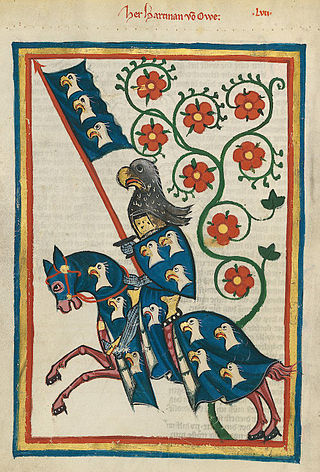
Hartmann von Aue, also known as Hartmann von Ouwe, was a German knight and poet. With his works including Erec, Iwein, Gregorius, and Der arme Heinrich, he introduced the Arthurian romance into German literature and, with Wolfram von Eschenbach and Gottfried von Strassburg, was one of the three great epic poets of Middle High German literature.

Tristan, also known as Tristram, Tristyn or Tristain and similar names, is the hero of the legend of Tristan and Iseult. In the legend, he is tasked with escorting the Irish princess Iseult to wed Tristan's uncle, King Mark of Cornwall. Tristan and Iseult accidentally drink a love potion during the journey and fall in love, beginning an adulterous relationship that eventually leads to Tristan's banishment and death. The character's first recorded appearance is in retellings of British mythology from the 12th century by Thomas of Britain and Gottfried von Strassburg, and later in the Prose Tristan. He is featured in Arthurian legends, including the seminal text Le Morte d'Arthur, as a skilled knight and a friend of Lancelot.
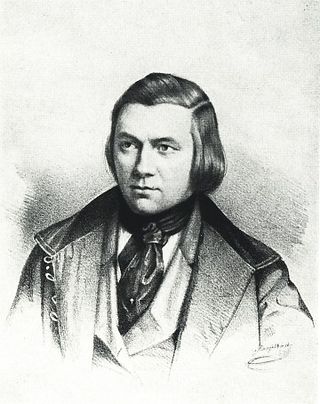
Hermann Kurz was a German poet and novelist.

Gottfried von Strassburg is the author of the Middle High German courtly romance Tristan, an adaptation of the 12th-century Tristan and Iseult legend. Gottfried's work is regarded, alongside the Nibelungenlied and Wolfram von Eschenbach's Parzival, as one of the great narrative masterpieces of the German Middle Ages. He is probably also the composer of a small number of surviving lyrics. His work became a source of inspiration for Richard Wagner's opera Tristan und Isolde (1865).
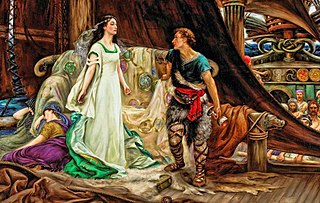
Tristan and Iseult, also known as Tristan and Isolde and other names, is a medieval chivalric romance told in numerous variations since the 12th century. Based on a Celtic legend and possibly other sources, the tale is a tragedy about the illicit love between the Cornish knight Tristan and the Irish princess Iseult. It depicts Tristan's mission to escort Iseult from Ireland to marry his uncle, King Mark of Cornwall. On the journey, Tristan and Iseult ingest a love potion, instigating a forbidden love affair between them.
Thomas of Britain was a poet of the 12th century. He is known for his Old French poem Tristan, a version of the Tristan and Iseult legend that exists only in eight fragments, amounting to around 3,300 lines of verse, mostly from the latter part of the story. It is calculated that this represents about one sixth of the original.

A concordance is an alphabetical list of the principal words used in a book or body of work, listing every instance of each word with its immediate context. Concordances have been compiled only for works of special importance, such as the Vedas, Bible, Qur'an or the works of Shakespeare, James Joyce or classical Latin and Greek authors, because of the time, difficulty, and expense involved in creating a concordance in the pre-computer era.
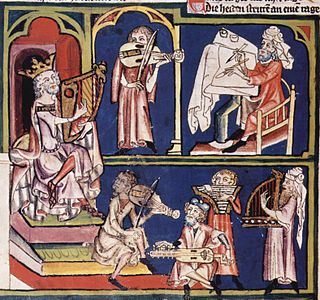
Rudolf von Ems was a Middle High German narrative poet.

Reinmar von Hagenau was a German Minnesänger of the late twelfth century who composed and performed love-songs in Middle High German. He was regarded by his contemporaries as the greatest Minnesänger before Walther von der Vogelweide, a view widely shared by modern scholars. Although there are uncertainties as to which songs can be reliably attributed to him, a substantial body of his work — over 60 songs — survives. His presentation of courtly love as the unrequited love of a knight for a lady is "the essence of classical Minesang".
Brian Oliver Murdoch is a British philologist who is Emeritus Professor of German at the University of Stirling. He specializes in the study of early Germanic and Celtic literature, on which he has authored and edited several influential works.

The European Association for Digital Humanities (EADH), formerly known as the Association for Literary and Linguistic Computing (ALLC), is a digital humanities organisation founded in London in 1973. Its purpose is to promote the advancement of education in the digital humanities through the development and use of computational methods in research and teaching in the Humanities and related disciplines, especially literary and linguistic computing. In 2005, the Association joined the Alliance of Digital Humanities Organizations (ADHO).
Susan Hockey is an Emeritus Professor of Library and Information Studies at University College London. She has written about the history of digital humanities, the development of text analysis applications, electronic textual mark-up, teaching computing in the humanities, and the role of libraries in managing digital resources. In 2014, University College London created a Digital Humanities lecture series in her honour.
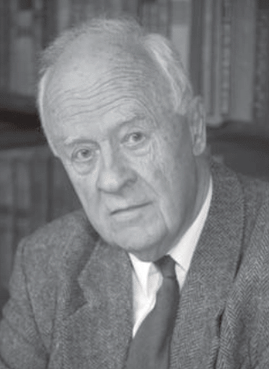
Dennis Howard Green was an English philologist who was Schröder Professor of German at the University of Cambridge. He specialized in Germanic philology, particularly the study of Medieval German literature, Germanic languages and Germanic antiquity. Green was considered one of the world's leading authorities in these subjects, on which he was the author of numerous influential works.
Arthur Thomas Hatto was an English scholar of German studies at the University of London, notable for translations of the Medieval German narrative poems Tristan by Gottfried von Strassburg, Parzival by Wolfram von Eschenbach, and the Nibelungenlied. He was also known for his theory of epic heroic poetry, and related publications. He retired in 1977, and in 1991 the British Academy elected him as a Senior Fellow.
Lou Burnard is an internationally recognised expert in digital humanities, particularly in the area of text encoding and digital libraries. He was assistant director of Oxford University Computing Services (OUCS) from 2001 to September 2010 where he officially retired from OUCS. Prior to that, he was manager of the Humanities Computing Unit at OUCS for five years. He has worked in ICT support for research in the humanities since the 1990s. He was one of the founding editors of the Text Encoding Initiative (TEI) and continues to play an active part in its maintenance and development, as a consultant to the TEI Technical Council and as an elected TEI board member. He has played a key role in the establishment of many other key activities and initiatives in this area, such as the UK Arts and Humanities Data Service, and the British National Corpus and has published and lectured widely. Since 2008 he has also worked as a Member of the Conseil Scientifique for the CNRS-funded "Adonis" TGE.
Harold Short is Emeritus Professor of King's College London. He founded and directed the Centre for Computing in the Humanities until his retirement (2010). He was involved in the development with Willard McCarty of the world's first PhD programme in Digital Humanities (2005), and three MA programmes: Digital Humanities, Digital Culture and Society, and Digital Asset Management.
Rudolf Henning was a German philologist who specialized in Germanic studies.
In the Middle High German (MHG) period (1050–1350) the courtly romance, written in rhyming couplets, was the dominant narrative genre in the literature of the noble courts, and the romances of Hartmann von Aue, Gottfried von Strassburg and Wolfram von Eschenbach, written c. 1185 – c. 1210, are recognized as classics.

David Nicholas Yeandle is a British Germanist and author. He is Emeritus Professor and Senior Research Fellow at King's College London and an Affiliated Lecturer in German at the University of Cambridge. He has published widely on German language and literature, including Old High German, Middle High German, and the modern German language. Since taking early retirement in 2010, he has further developed a research interest in ecclesiastical history, particularly of the Anglican Church.












